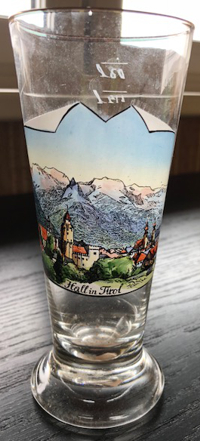

|
| ÖSTERREICH | AUSTRIA |
| Bundesland: Tirol | Tyrol |
| Bezirk: Innsbruck-Land |
 Hall in Tirol is situated at an elevation of 574 m in the Inn valley, about 10 km east of
Innsbruck. From 1938 until 1974 the official name was Solbad Hall. The municipality has
a population of about 13,800 (2017).
Hall in Tirol is situated at an elevation of 574 m in the Inn valley, about 10 km east of
Innsbruck. From 1938 until 1974 the official name was Solbad Hall. The municipality has
a population of about 13,800 (2017).
Hall in the County of Tyrol was first mentioned as a salina (saltern) near Thaur castle in a 1232 deed. The current name dates back to 1256 and is derived from the Celtic word for salt (similarly to Halle, Hallein, Schwäbisch Hall or Hallstatt). Since the 13th century the salt mine at Absam in the Hall Valley north of the town formed the main industry of the town and its surroundings. The first adit was laid out in 1272at the behest of Count Meinhard II of Tyrol, with the brine channeled by a 10-km-long pipeline to the evaporation pond at Hall. In 1303 Hall became a town. The rights that came with this, as well as the business associated with trading from Hall downriver on Inn and Danube, turned it into the leading market and trading place in the northern parts of Tyrol. In 1477 it got the right of coinage, when the Tyrolian mint was moved from Meran to Hall. In 1486 the mint produced the first large silver coin (Guldengroschen) in Europe. In the 16th century the mint in Hall also introduced the world's first automated coining machine. Today a reconstruction of this revolutionary machine can be seen in the Hall Mint Museum. In the 15th and 16th century, Hall was one of the most important towns in the Habsburg Empire. This period saw the construction of many of the churches, monasteries and convents that still shape the appearance of the town. Today Hall has the biggest intact old town in the western part of Austria. During the Habsburg Monarchy a military garrison was established in Hall. This, along with the large freight train station, became a target of heavy bombardment during World War II, which destroyed the train station but fortunately left the old town almost unscathed. From 1938 to 1974 the town was called Solbad Hall; the name was changed to the present name Hall in Tirol in 1974 because salt mining had been discontinued in 1967.
 Hasegg castle was completed soon after 1300, when Hall was rapidly becoming the center of
Tyrolean commerce and salt mining. The building was originally erected to protect the salt mines, the shipping industry,
the bridge across the river Inn and the old Roman Road. The castle's mint was established by Sigismund, Archduke of Austria
in 1477. The first dollar-size silver coin was struck in 1486: the Guldengroschen. When Archduke Ferdinand II of
Austria had the old mint transferred from the Castle of Sparberegg to Hasegg in 1567, Hall experienced a decisive upswing.
Between 1748 and 1768, Hasegg Castle
became universally famous for its minting of silver Thalers of which it produced over 17 million specimens. The mint
ceased production in 1806 due to the Napoleonic Wars and the increasing lack of local silver resources. The mint in Hasegg
Castle is a museum now, and open to the general public. The castle itself is an example of early Gothic era Tyrolean
fortress architecture. The pointed roof of the mint tower is of heavily tarnished copper.
Hasegg castle was completed soon after 1300, when Hall was rapidly becoming the center of
Tyrolean commerce and salt mining. The building was originally erected to protect the salt mines, the shipping industry,
the bridge across the river Inn and the old Roman Road. The castle's mint was established by Sigismund, Archduke of Austria
in 1477. The first dollar-size silver coin was struck in 1486: the Guldengroschen. When Archduke Ferdinand II of
Austria had the old mint transferred from the Castle of Sparberegg to Hasegg in 1567, Hall experienced a decisive upswing.
Between 1748 and 1768, Hasegg Castle
became universally famous for its minting of silver Thalers of which it produced over 17 million specimens. The mint
ceased production in 1806 due to the Napoleonic Wars and the increasing lack of local silver resources. The mint in Hasegg
Castle is a museum now, and open to the general public. The castle itself is an example of early Gothic era Tyrolean
fortress architecture. The pointed roof of the mint tower is of heavily tarnished copper.
[https://de.wikipedia.org/wiki/Hall_in_Tirol, https://en.wikipedia.org/wiki/Hall_in_Tirol;
https://en.wikipedia.org/wiki/Hasegg_Castle]
![[scale]](lineal.jpg)